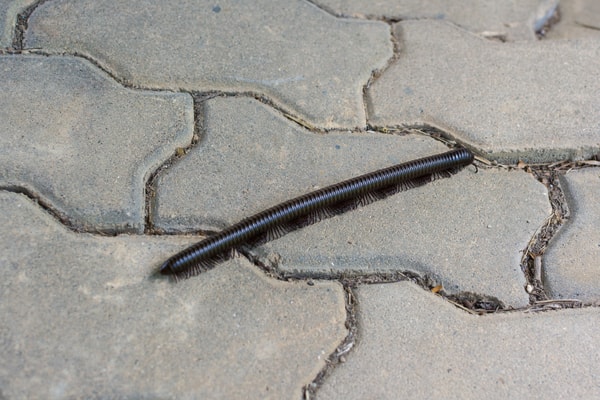Millipedes are unique and fascinating creatures. There are currently 7,000 species of millipedes that cover the globe, of which 1,400 varieties live in North America alone. Millipedes are native to all 50 states as well. They can be black, brown or red in color, and one species in California's Sierra Nevada Mountains actually glows in the dark.

Millipedes require a moist habitat. You are most likely to encounter them in your garden or yard, especially where the thatch (layer of grass, roots and stems between the grass blades and soil) is loose. Although a few species feed on animal remains or fungi, most millipedes eat decaying leaves and other dead plant matter.
Millipedes can become household pests during the fall months. As temperatures cool and the ground begins to harden, they may migrate from their normal feeding areas and invade your home. Because they crawl, millipedes are most commonly spotted on lower floors and in basements and bathrooms. The majority of millipedes that stray into your home eventually die from lack of moisture. In wetter basements, however, it’s possible for them to survive for longer periods of time.
What are millipedes?
The name “millipede” comes from Latin, meaning “1,000 feet.” However, the typical millipede possesses far fewer feet than that, with most species sporting between 40 and 400 pairs of legs. Millipedes are arthropods, but because they have more than six legs, they are not insects. In fact, their relatives are centipedes and pillbugs.
Are millipedes a threat to humans?
Millipedes are not known to bite, sting or infest food. However, some species take other defensive measures when they feel threatened. These millipedes may secrete a mild form of pungent hydrochloric acid to deter predators. This toxin can burn and discolor bare skin and may be dangerous to your eyes. Some individuals may experience an allergic reaction to this substance as well. Therefore, exercise caution with millipedes and do not handle them with your bare hands.
What are the best ways to help control millipedes?
Make the areas adjacent to and inside your home as inhospitable as possible to millipedes to help reduce their numbers.
- Remove piles of leaves, mulch, compost and other litter from the immediate vicinity around your home’s exterior.
- Help make your home less attractive to millipedes in search of moisture or refuge from seasonal changes. Make sure your doors and windows fit tightly. Have any foundation cracks repaired and be sure any gaps above your home’s foundation are sealed. Likewise, caulk any cracks and crevices that may permit millipedes to enter your home.
Although millipedes do not usually survive long once inside your home, you may need to take some preventive measures to help ensure they don’t linger and grow into a nuisance.
Remove as much clutter as possible (especially empty or disintegrating cardboard containers) from your basement and garage.
- Caulk any potential hiding places, such as along your baseboards.
- Place a dehumidifier in damp areas.
- Remove any millipedes you locate inside your home using a broom or vacuum cleaner.
If these steps aren’t enough to provide proper peace of mind or you'd just like professional help from the start, call Terminix® and let our pest control professionals help you address your millipede problem.


